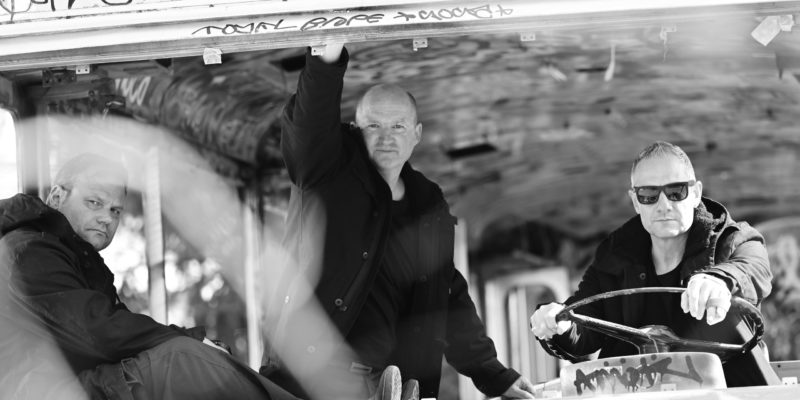Fully immersive synth rock and conceptual depth unite beautifully, across a repertoire of superb songwriting and a fearlessly unique, impassioned style. Emily Kinski’s Dead are a fantastic indie band of our time, and their music is connecting far and wide.
Following the release of their stunning new album Black Light District, and prior to a series of live appearances, we caught an interview with synth-player Thomas, to find out more about the band’s impressive journey, and their powerfully engaging approach to making music. Here’s the conversation in full.
* * *
Hi Thomas – amazing to finally catch up with you, Happy New Year! How have the first two weeks of 2025 been treating you?
Very good, we’re currently working in Spain on the first songs for our 3rd album and are shooting the music video for Cold Comfort from Black Light District.
For those new to your journey – how did Emily Kinski’s Dead first come to be, and why this band name?
We are Oliver Spring (vocals), Thomas Kowa (synthesizer), and René Ebner (drums). We are Emily Kinski’s Dead, a German-Swiss project dedicated to the New Wave and Post-Punk of the 80s.
Rene and Thomas started making music in Germany in the late 80s and formed the band No Comment. We produced a mix of synth-pop and EBM and released several CDs. In the 90s, Oliver was also creating EBM with the Swiss band Sleepwalk. We met through a remix of No Comment for Sleepwalk.
When Thomas later moved to Switzerland, the three of us joined forces to form the EBM band Nine Seconds, with which we released four albums. Then we felt drawn to the early 80s New Wave sound and, with the same line-up, started the band Emily Kinski’s Dead. In 2023, our debut album, A Time to die and a Time to love, was released, followed by our latest album, Black Light District. In it, you can hear our past as an electronic band and our future in post-punk.
When choosing the band name, we wanted one where you could already tell from the name what kind of music we make. It should also be somewhat provocative, so we kept searching until all three of us said: Yes, Emily Kinski’s Dead, that’s it.
Last year you released the iconic indie project Dancing on The Battlefield – cascading layers of synths, rhythms and nostalgic warmth, with poetic stories and melodies that naturally captivate. Who or what first inspired you to adopt this kind of style and sound?
We always dreamed of writing a song that The Sisters of Mercy could have recorded in the 80s – and with Dancing on the Battlefield, it just happened naturally.
What was it about post-punk and the new wave of the eighties that drew such interest and passion from you?
Our roots lie in the early 80s, with influences from New Wave and Post-Punk, particularly Joy Division, The Cure, Sisters of Mercy and Clan of Xymox, from whom we also covered the song Emily for the album. We love the 80s vibe and the sound of that time, especially as it has all become relevant again today.
What does the leading song Dancing on the Battlefield represent for you conceptually and artistically?
The inspiration for the song was our frustration over the fact that, despite all the evidence about climate change being on the table, no action is being taken. Measures are simply postponed to the future, and even the wealthy countries are doing far too little. I don’t even remember exactly what sparked it – there are shocking news reports almost weekly, and far fewer that give hope.
The video is also compelling in its retro darkness and simplicity. What was the creative process like for the visuals when compared to writing and studio time for music?
We developed the script for the music video together with director Fabio Rincones, with the goal from the very beginning to highlight the dispute between Emily and the fossil manager, which is also central to the song. Everything else was then independently developed by the director – in consultation with us. …and we were thrilled with the result.
Why Can’t You Love Me is notably heavier by design, with warped or canned vocals still distinct but hazier and more atmospheric within the mix. Why this change in tone for this topic, and what are the underlying themes or stories that inspired the writing of this track?
Why Can’t You Love Me delves into the mind of a serial killer and his perception of love. However, this only becomes apparent towards the end of the song—before that, it feels like a love song. We wanted to reflect this musically as well, structuring the song into three distinct parts.
Dancing on the Battlefield and Why Can’t You Love Me? are connected by their deep exploration of the darkest corners of the human soul. And, to put it sarcastically, a fossil manager is essentially just a serial killer—only with more money and more indirect methods.
What’s a live show like from Emily Kinski’s Dead, and do you have any noteworthy shows coming up soon?
At our live shows, we are joined by guitarist Steph Kohler, who adds even more dynamism and energy to our performances. Our next gig is on 23rd February at Ono in Bern, which will also double as the release party for the vinyl edition of Black Light District.
The EP and your social streams are doing incredibly well. What would you say has been the main tool or step used to achieve this kind of growth as an independent act?
We simply make the music we love and have found the right people to help us bring our ideas to life visually.
Your album A Time to Love and a Time to Die was openly inspired by the novel by Erich Maria Remarque. How often do different artforms intertwine and inspire you like this, and do you ever envision your music accompanying other forms of media?
I (Thomas) am also a writer myself, so it’s not uncommon for literary themes or films to inspire us. Erich Maria Remarque had a huge influence on me (and on Rene) during my youth, especially with All Quiet on the Western Front.
Later, I also developed a deep appreciation for his other works. With our band Nocomment, Rene and I once scored an entire album as a feature film—the surround-pop movie Polyradah. Unfortunately, it attracted little interest at the time because the format was so unconventional. Nevertheless, we still create a music video for every Emily Kinski song, as the visual aspect remains incredibly important to us.
Does your creativity manifest itself in any other ways?
Yes, the three of us also make up the EBM band Nine Seconds. Oli also sings for Teardown, and I (Thomas) for Purwien & Kowa. On top of that, I host Disko 80, the most successful German-language podcast about 80s music, and I’m also a writer. So, we’re all active on multiple levels—sometimes in the spotlight, sometimes behind the scenes.
Does the band ever disagree creatively, or is the escapism of the process the main thing that unites you all?
Of course, we discuss songs and decisions, but mostly before we fully start working on a track. If all three of us don’t stand behind the final result, it won’t be released. If any of us have doubts, the song might become a bonus track instead—ensuring that the core of our work always resonates with all three of us.
What do you have planned for the year ahead?
We’ll be releasing another single from the album Emily and creating a video for every song on the album. At the same time, we’re already working on demos for the third Emily Kinski album—and so far, we’re really happy with how it’s coming together.
We’re also hoping for many more live shows—so if you’d like to see us perform, feel free to get in touch!
Is there anything else we should know?
Just listen to Black Light District and subscribe to our YouTube channel—then you’ll always be up to date with everything you need to know about us! 😊
* * *
Find Emily Kinski’s Dead on Instagram or visit their Website.

